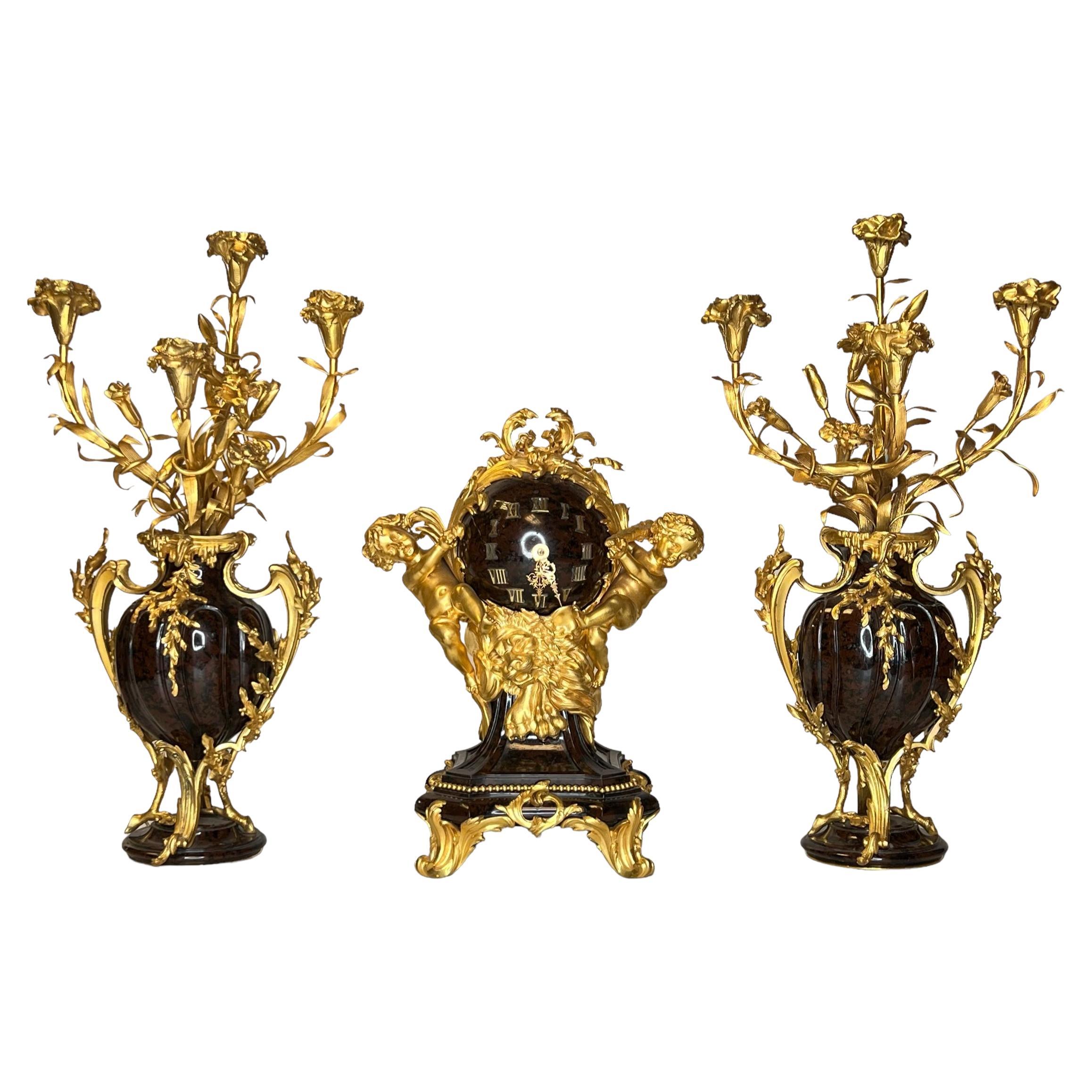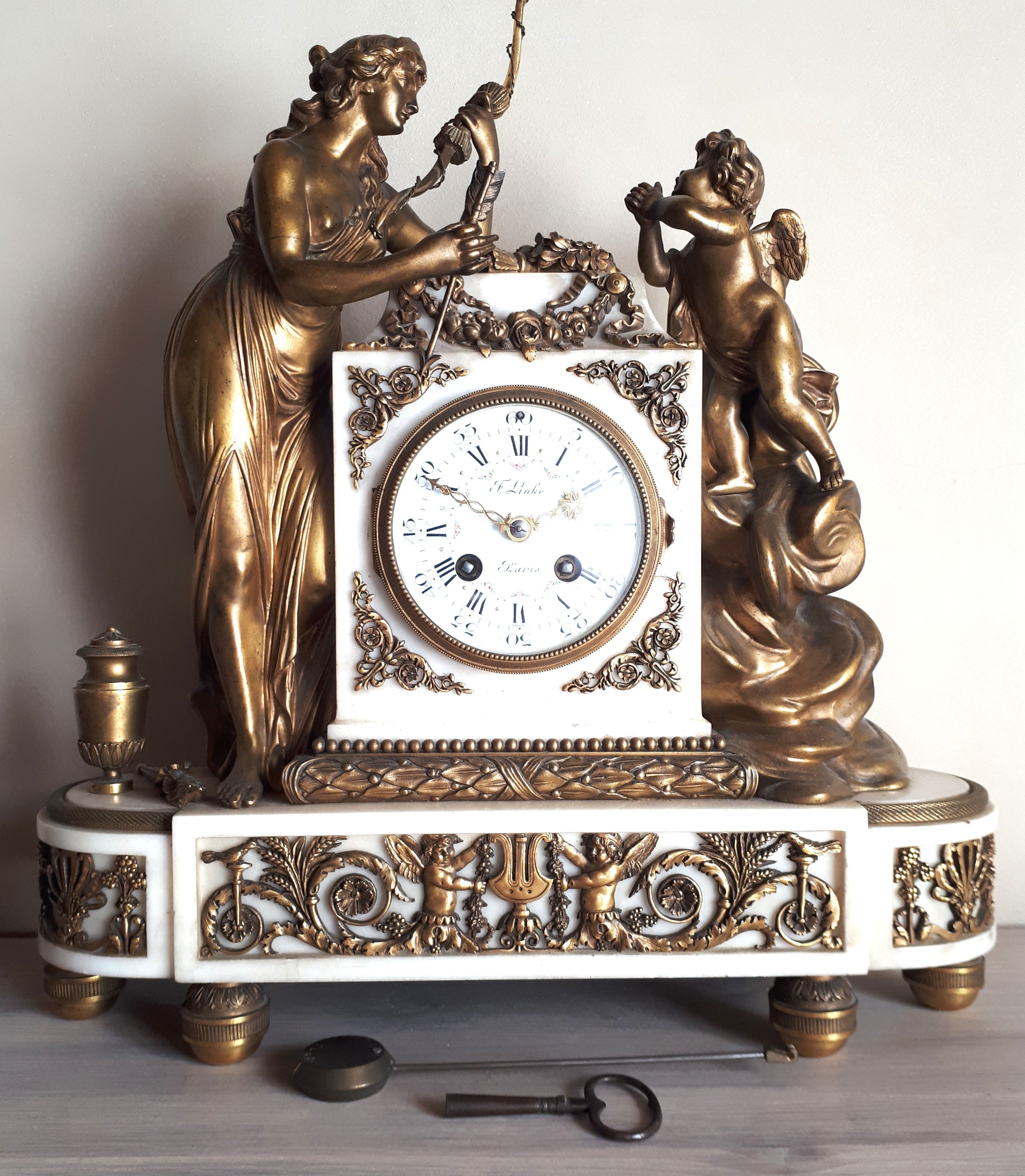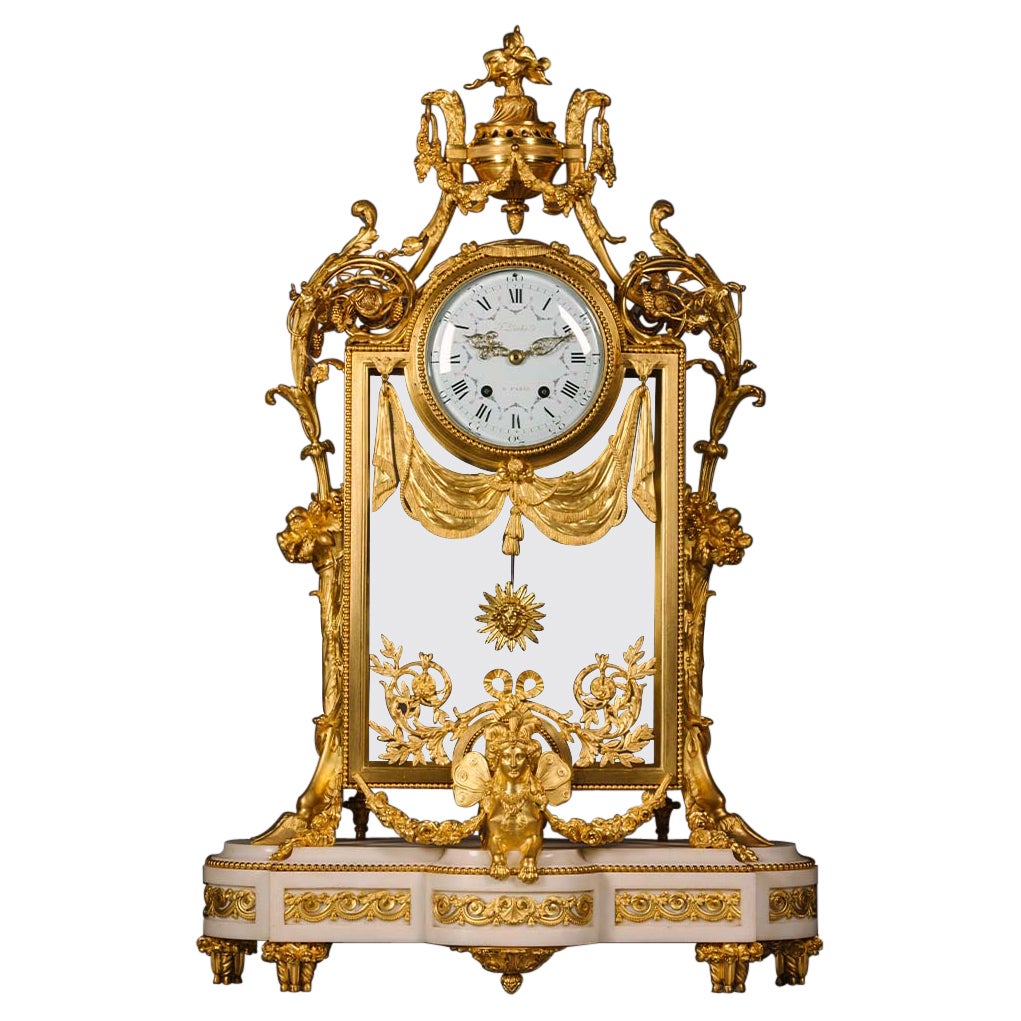Items Similar to Attributed to L.Messagé (1842-1901) and F.Linke, "Source Allegory" Clock
Want more images or videos?
Request additional images or videos from the seller
1 of 10
Attributed to L.Messagé (1842-1901) and F.Linke, "Source Allegory" Clock
About the Item
Attributed to Leon Messagé (1842-1901) and François Linke (1855-1946)
Gilt bronze clock surmounted by an allegory of the Source.
With rocaille decoration, resting on four cambered legs, gilt bronze terrace.
Rich repertoire of rocailles
White enamel dial with Roman and Arabic numerals.
Louis XV style
Original and key, in working conditions
H 26 W 14.5 D 9 cm
Bibliography: C. Payne, Francois Linke 1855-1946: The Belle Epoque of French Furniture, Antique Collector's Club Ltd, Woodbridge, 2003, pl. 104, p. 93 (details) and pl. 102, p. 92, for an illustration of a similar clock
Léon Messagé was born March 8, 1842 in Sens, Yonne. At 20 years old, he lived in Paris at 23 rue de Rivoli and was then referred to as "stone carver." Around 1885, he began collaborating with François Linke, important cabinetmaker of the Belle Epoque, providing him models for furniture and ornamental bronzes. They collaborated until the death of Messagé, who lived until the age of 58 and died May, 16 1901. It is through this collaboration with François Linke, that Messagé would be successful during the last decades of the nineteenth century. In fact, Messagé was awarded a gold medal at the 1889 World Fair and it was he who designed all the important furniture for the stand of François Linke for the Universal Exhibition in 1900.
Even though he worked hard for Linke, Messagé still remained an independent craftsman, working on his own account. In his studio at 40 rue Sedaine, in the 11th arrondissement of Paris, he was the designer and creator of its models. The fundamental principle of the de-signs by Messagé is a light rococo, a characteristic asymmetry of rock that Parisian artisans developed in the 1720s.
François Linke, born in 1855 in Bohemia (Czechoslovakia), worked as a cabinet-maker in Paris from about 1882 until his death in 1946. In 1900, at the apex of his career, he opened a new shop at the famous Parisian place Vendôme. He specialized in Louis XV and Louis XVI style furniture: all pieces were beautifully mounted with gilt-bronze ornaments, and he received numerous commissions. Later Linke decided to collaborate with the well-known sculptor Léon Messagé and integrated new lines and shapes announcing the “Art Nouveau” style. His great success is definitely the 1900 Universal Exhibition where he was awarded the gold medal for his extraordinary kingwood desk, designed by Messagé. At this occasion, the “Revue artistique et industrielle” commented that “Linke’s stand is the biggest show in the history of art furniture”.
- Attributed to:François Linke (Retailer)Léon Messagé (Manufacturer)
- Dimensions:Height: 10.24 in (26 cm)Width: 5.71 in (14.5 cm)Depth: 3.55 in (9 cm)
- Style:Napoleon III (In the Style Of)
- Materials and Techniques:
- Place of Origin:
- Period:
- Date of Manufacture:circa 1890
- Condition:Wear consistent with age and use. working mouvement.
- Seller Location:Saint-Ouen, FR
- Reference Number:1stDibs: LU2612339357152
About the Seller
4.9
Vetted Seller
These experienced sellers undergo a comprehensive evaluation by our team of in-house experts.
1stDibs seller since 2017
57 sales on 1stDibs
Typical response time: 2 hours
- ShippingRetrieving quote...Ships From: Saint-Ouen, France
- Return PolicyA return for this item may be initiated within 2 days of delivery.
More From This SellerView All
- A French ‘Chariot’ Three-pieces Clock Garniture attributed to F.Linke circa 1890By François LinkeLocated in Saint-Ouen, FRA French Ormolu and Patinated-Bronze ‘Chariot’ Three-pieces Clock Garniture Attributed to François Linke (1855 - 1946), Paris, Late 19th/ Century The clock representing a putto on ...Category
Antique 1890s French Napoleon III Mantel Clocks
MaterialsBronze, Ormolu, Enamel
- Fannières Frères Desk Clock "Time Allegory" circa 1860By Fannière FrèresLocated in Saint-Ouen, FRFannières Frères Desk Clock Time Allegory Chased gilt and silvered bronze Desk Clock With an allegorical theme of Time in the form of a cherub suppor...Category
Antique 1860s French Louis XVI Table Clocks and Desk Clocks
MaterialsMarble, Bronze, Ormolu
- Very Impressive French 19th Century Neoclassical Lyre-Form ClockBy Etienne LeNoirLocated in Saint-Ouen, FRAn impressive French 19th century Neoclassical Lyre-form clock with jeweled pendulum. Amazing quality white and yellow marble 19th century French Lyre-Form clock mounted all over with gilt bronze...Category
Antique 1850s French Louis XVI Mantel Clocks
MaterialsCrystal, Marble, Enamel, Ormolu
- A French Napoléon III Ormolu Cartel Clock by Susse Frères Paris circa 1870By Susse FreresLocated in Saint-Ouen, FRA French 19th Century Cornucopia Gilt-Bronze Cartel, by Susse Frères Paris An Ormolu Cartel in the shape of an escutcheon, with a circular white enamel dial, signed Susse Frères/A Paris, Arabic numerals for the hours and for the minutes. It's bordered by a frieze of pearls and surmounted by a falling laurel knot with a drapery in the lower part and flanked by cornucopias adorned with flowers and fruits. Rectangular base decorated with a garland of knotted flowers dying in a tapered, fluted barrel and damping, in the upper part, a flowery Medici vase. Louis XVI Style Circa 1870 Original gilding uncleaned The Susse company, a worldwide reknown foundry, began to cast pieces as soon as the first half of the 19th Century. Awarded medals...Category
Antique 1860s French Louis XVI Wall Clocks
MaterialsOrmolu
- French 19th Century Aesthetic Movement Chinoiserie Timepiece by Susse FrèresBy Susse Freres, L'Escalier de CristalLocated in Saint-Ouen, FRA very fine bronze brown and gilt patina French 19th century timepiece in the oriental Chinese taste. In an Archaic style bell with molded relief dragons circling body, surmounted by...Category
Antique 1860s French Chinoiserie More Clocks
MaterialsBronze
- Impressive French 19th Century Neo-Greek Style Bronze Nine-Lights CenterpieceBy Georges Emile Henri ServantLocated in Saint-Ouen, FRAn impressive French 19th century Neo-Greek style bronze nine-lights center piece In patinated and gilt bronze, engraved on the body of foliage and rings, the collar decorated with a frieze of palms in bas-relief. It is held by a tripod base decorated with shards, foliage, and fins, in the center a mask of man. Surmounted by three arms, nine-lights ending in lion’s paw. Curved triangular base with ivy friezes, and palm-leaf feet. Attributed to Georges Emile Henri...Category
Antique 1860s French Napoleon III Vases
MaterialsBronze
You May Also Like
- Francois Linke Louis XVI Style Gilt Bronze and Marble Mantel Clock GarnitureLocated in New York, NYExceptional garniture in the Louis XV/XVI style with gilt bronze mounts attributed to Léon Messagé (1842-1901) and Francois Linke (1855-1946), including mantel clock and pair of cand...Category
Early 20th Century French Louis XV Mantel Clocks
MaterialsMarble, Bronze
- Fine French Gilt-Bronze and Rouge Griotte De Campan Table Clock by Léon MessagéLocated in New York, NYMaker: Léon Messagé (1842-1901) Origin: Paris, France Date: Early 20th century Size: 11 3/4 in x 9 in x 6 1/4 in. Signature: signed Messagé to the right side of the lion pelt...Category
Antique 19th Century French More Clocks
MaterialsBronze
- Mantel clock - pendulum by François Linke in marble and gilded bronzeBy François LinkeLocated in Saverne, Grand EstMagnificent composition for this clock in marble and chiselled, gilded and patinated bronze depicting Venus disarming Cupid, who begs the goddess to return him bow and arrow. The whi...Category
Antique Late 19th Century French Louis XVI Mantel Clocks
MaterialsMarble, Bronze
- Louis XVI Style Gilt-Bronze and Glass Mantel Clock by Francois LinkeBy François LinkeLocated in Brighton, West SussexA very rare Louis XVI style gilt-bronze and glass, Pendule a cage, by Francois Linke, with a white marble base. Linke Index no. 076'. Linke Title: 'pendule a cage'. Signed to th...Category
Antique 18th Century French Louis XVI Mantel Clocks
MaterialsBronze
- Important Exhibition Encrier by François Linke and Léon Messagé, circa 1900By François LinkeLocated in Brighton, West SussexA very rare and important exhibition encrier by François Linke and Léon Messagé. French, circa 1900. Index number 709. Signed to the edge 'F. Linke'. This exceptional and ambitious encrier is modelled as two putti, each holding a standard and sitting on the water's edge, the two inkwells with hinged spirally-fluted covers with glass liners. This important inkwell is based on Léon Messagé's celebrated sculptural group 'La Source' and was originally intended by Linke to form part of his spectacular Stand at the 1900 Paris Exposition Universelle. Like seven or eight other pieces originally intended for inclusion on the Stand, it would seem the encrier was a casualty of both Linke's over-ambitious production schedule and the financial burden that the manufacture of such ornate and high quality work imposed. It was eventually shown on the Stand in September after the gilding was finished by Picard at a cost of 90 French francs. The costs of the model were very high: some 2024 francs (of which Message's combined fee was 1158 francs 40 centimes), underlining the originality and complexity. The 1900 Exposition example was sold, along with three important pieces of furniture from the Stand (the Grand bureau and associated armchair, and the Bahut Louis XV Mars et Vénus), to the South African banker and diamond merchant Solomon Joel. A further six encriers were produced up until 1925. Object Literature: Payne, Christopher. François Linke, 1855-1946, The Belle Époque of French Furniture, p. 90, pl. 97; p. 149, pl. 157; p. 150; pp. 182-183, pls 197 & 198 as exhibited at the Liege exhibition in 1905 & p. 480 for the original notes in Linke's Blue daybook of the late 1890s. François Linke (1855 - 1946) was the most important Parisian cabinet maker of the late nineteenth and early twentieth centuries, and possibly the most sought after cabinet maker of his period. He was born in 1855 in the small village of Pankraz, in what is now the Czech Republic. Records show that Linke served an apprenticeship with the master cabinetmaker Neumann, then in 1875 at the age of 20 he arrived in Paris where he lived until he died in 1946. It is known that the fledgling Linke workshops were active in Paris in the Faubourg St. Antoine as early as 1881, and during this time he supplied furniture for other more established makers such as Jansen and Krieger. The quality of Linke's craftsmanship was unsurpassed by any of his contemporaries and reached its peak with his spectacular Stand at the Paris Exposition Universelle in 1900, where his Grand Bureau took the Gold Medal. He gambled his fortune and reputation on this Stand, exhibiting several breathtaking items of furniture with sculptural mounts of the most exceptional quality and proportion. His gamble worked and his reputation was established to such an extent that Linke continued to be the pre-eminent furniture house in Paris until the Second World War. As the Art Journal reported in 1900 on Linke's Stand: 'The work of M. Linke ... was an example of what can be done by seeking inspiration amongst the Classic examples of Louis XV and XVI without in any great sense copying these great works. M. Linke's work was original in the true sense of the word, and as such commended itself to the intelligent seeker after the really artistic things of the Exhibition. Wonderful talent was employed in producing the magnificent pieces of furniture displayed....' The formation of Linke's distinctive style was made possible by his collaboration with the sculptor Léon Messagé. Together Linke and Messagé designed furniture for Linke's 1900 exhibition Stand, with exuberant allegorical figures cast in high relief, that exemplified Linke's ability to seamlessly merge the different mediums of wood carving, bronze and marquetry into a dynamic unified whole. Today Linke is best known for the exceptionally high quality of his work, as well as his individualism and inventiveness. All of his work has the finest, most lavish mounts, very often applied to comparatively simple carcasses. The technical brilliance of his work and the artistic change that it represented were never to be repeated. Bibliography: Payne, Christopher. François Linke, (1855 - 1946), The Belle Époque of French Furniture, Antique Collectors' Club, (Woodbridge, UK), 2003. Meyer, Jonathan. Great Exhibitions - London, New York, Paris, Philadelphia, 1851-1900, Antique Collectors' Club, (Woodbridge, UK), 2006; pp. 298 - 300. LeDoux - Lebard, Denise. Les Ébénistes du XIXe siècle, Les Editions de l'Amateur, (Paris), 1984; pp. 439-43. Revue Artistique & Industrielle, (Paris), July-August 1900. Coral Thomsen, D. (ed), The Paris Exhibition 1900, The Art Journal, 1901; p.341. Léon Messagé (1842-1901) had a brilliant, but short lived career. He is best known for his incredible sculptural collaboration with François Linke for the 1900 Paris Exposition Universelle. A gifted sculptor, Messagé was also responsible for much of the design and creative work for Roux et Brunet and Joseph-Emmanuel Zwiener. Messagé enjoyed great success as a designer/sculptor before his collaboration with Linke. Indeed he was mentioned as a Gold Medal winner at the 1889 International Exhibition and was especially praised for his work on a cabinet by Zwiener. He came into contact with Linke in 1885 and it appears from then on Linke employed him on a regular basis. Messagé was primarily influenced by Rococo ornament but he strove to re-interpret it. He did not produce slavish copies, and his original approach can be appreciated in Linke's celebrated Grande Bibliothèque and Grand Bureau exhibited at the 1900 Paris Exposition Universelle. A number of drawings by Messagé are recorded and after his success at the exhibition of 1889 he was encouraged to publish his designs. 'Cahier...Category
Antique Late 19th Century French Louis XV Inkwells
MaterialsBronze
- Louis XVI Style Gilt Bronze and White Marble Clock By François Linke, circa 1890By François LinkeLocated in Brighton, West SussexA fine Louis XVI style gilt bronze and white marble clock depicting Diana and Cupid, by François Linke. French, circa 1890. Signe...Category
Antique Late 19th Century French Louis XVI Mantel Clocks
MaterialsMarble, Bronze





